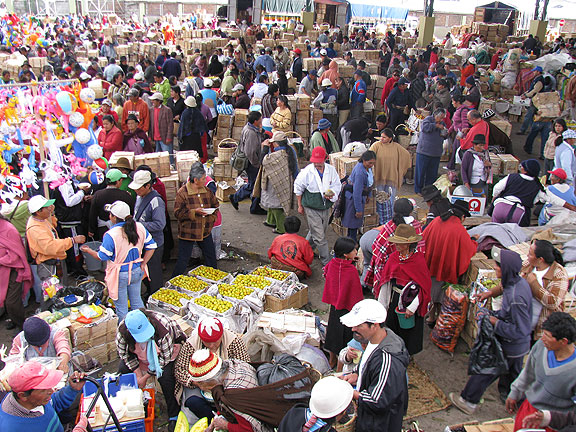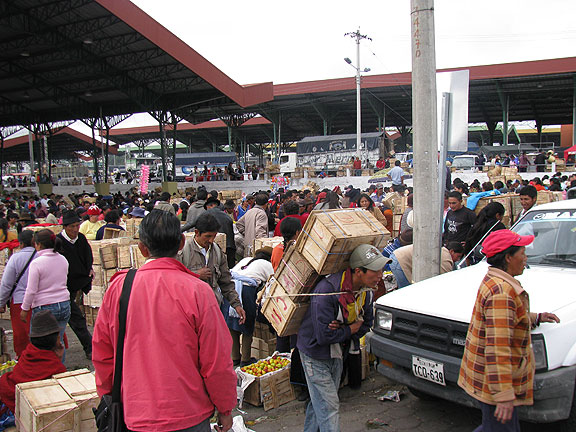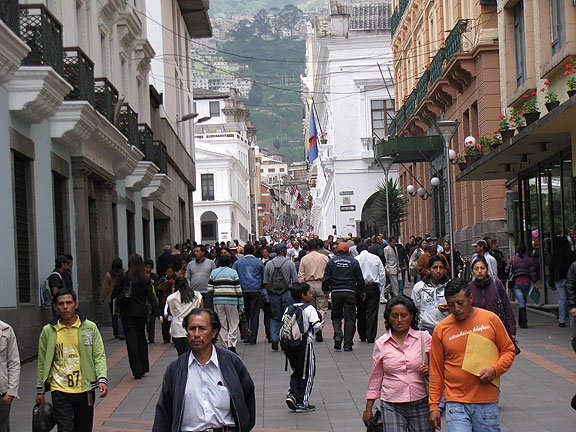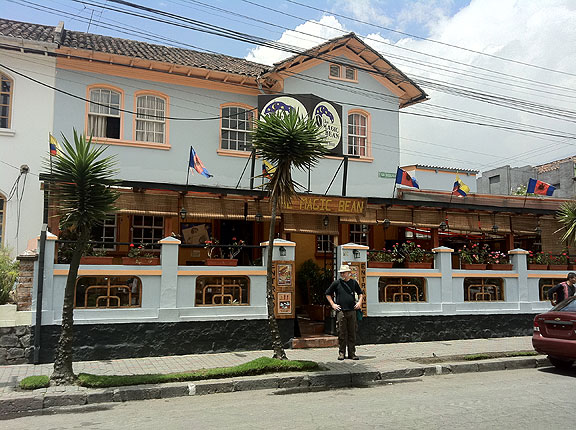Recent Posts
-
Real Crimes and the Coming Violence
September 6, 2025
-
Whither Modern Life?
June 27, 2025
-
What the Hell
June 18, 2025
-
As Darkness Engulfs Us
April 6, 2025
-
AI, Risk, and Work
January 17, 2025
-
“Things Are in the Saddle, and Ride Mankind”
December 29, 2024
-
Forgotten Futures in Seattle
December 12, 2024
-
Autocracy Defeats Neoliberalism
November 14, 2024
-
History… We’re Soaking in It!
October 2, 2024
-
A Numbing Spectacle
September 22, 2024
|
We took a bus trip down the Andes to Ambato from Quito. (I’m writing this now in Arequipa, Peru, almost two weeks after we did it… it’ll take me a while to catch up with all the stops on this amazing journey. It’s been a deluge of new experiences, sights, and ideas nearly every day with hardly any downtime until now.) Ambato is a bustling city sitting in a fold in the mountains, a central market town that has a population around 350,000, but a huge hinterland. We’d heard they have an amazing fruit and vegetable market and that the annual Festival of Fruits and Flowers would be happening while we were there. Turns out it was starting a few days later, so we missed the festival, but we did make it to the Mercado de Mayoristas (The Wholesale Produce Market).
 The Ambato Mercado de Mayoristas... what a beautiful market! We arrived in Ambato on a Sunday night, full of anticipation for the Monday morning market. Our hotel was a bit seedy, right in the heart of the City, next to one of the three markets. Turned out to be incredibly noisy, with dozens of buses and taxis roaring by all night, and by dawn, the streets were jammed with students on their way to school, countless people coming and going, buying and selling. But the night before we asked the hotel concierge if there was anything going on and he suggested we take a cab to a neighborhood music festival. We did, and it was eerie, riding in the cab through completely deserted streets. No cars parked anywhere (a recurrent experience as we made our way through Ecuador–nighttime streets are devoid of cars or people!) and when we came to the festa, it was over. So we had the cab turn around and take us back.
The next morning we went a block to the nearest market and made inquiries, which led us to grab a cab to the very outskirts where our Quito bus had unceremoniously dumped us (as opposed to a terminal in the city) the previous day. There we came to the Mercado de Mayoristas and had a splendid few hours wandering around enjoying the smells, sights, tastes, and friendly people.
Most of this post is in the form of photos and captions, so read on…
 This was our first view of the sprawling Mercado de Mayoristas.  We got a high spot for some great views...  The vibrancy of the market was irresistable. After a pause to drink it all in, we started to make our way into it.  This charming woman was selling small plastic bags with fresh potato mash, with salsa and onions... Adriana didn't take long to decide she wanted one. Continue reading Ambato to Guaranda–Fruits of Travel!
 Quito, Ecuador, historic center: as I always discover when leaving the U.S., people and cities elsewhere are generally much more civilized. Look at this dense pedestrian zone in Quito's center! We landed in Quito, Ecuador on Feb. 21 and made our way to the Magic Bean hostel without any trouble. As the driver let us out though, he seemed really nervous and warned us that we were in a difficult area. Hard to believe when we woke up the next morning and walked a block from our hotel (somewhat nervously) and found a thriving commercial district, with a fairly gentrified feeling to it, including plenty of upscale clothing stores and restaurants.
 I'm standing in front of the Magic Bean here on the first morning--seems fine now!  The Marsical district in the daytime is a fun melange of old refurbished buildings and new boring architecture. In fact, we had a wonderful 6 days in Quito, mostly visiting new friends in the local bicycling scene. (There is a more complete report on that over at sf.streetsblog.) We rode bikes all over thanks to the loaners from Frank at Cicleadas del Rey and the wonderful guidance and company he gave us, along with the charming Mashol and equally engaging Pablo. Here’s a moment when Mashol was in conversation with Adriana while we were riding uphill on one of the many nice separated bikeways, or ciclovias, in Quito.
 Mashol and Adri in conversation cycling uphill from Mariscal district in Quito. But the title of this post became our code to each other because wherever we went, and whomever we spoke with, all gave us urgent warnings about public safety. We both have traveled extensively so we tend to take such warnings pretty lightly, but it did affect us after a while, how consistently we were being told that it just wasn’t safe to walk places, to go up and down the scores of alluring staircases that ascend the towering slopes on either side of Quito, or to be anywhere at all after about 9 pm! In fact we learned that most of Ecuadorian city life shuts down very early, which we noticed as we’d be walking around. Suddenly the streets which had been bustling and lively were eerily empty. And then Mr Hyde would begin to appear. We figured some deal had been made (a la The Wire) in which the police agreed to leave the dealers and prostitutes alone if they keep away from some specified zones that were Quito’s night life, in particular a block from our hostel, the Plaza Mariscal Foch, which was heavily patrolled by police and even heavy-weapon carrying military on Saturday night!
Continue reading Quito: Dr Jekyll and Mr Hyde
 The plum blossoms outside my window are stunning in the faux summer of early February, but a nice complement to the springtime emerging in Egypt, Tunisia, across North Africa and the Middle East. The Egyptian Revolution is continuing. Today on Democracy Now’s ongoing fantastic coverage from the ground in Tahrir Square, they interviewed a man who with an almost devilish look on his face, smiling while he acknowledged that the slowness of the government’s response was greatly helping the movement to become deeper and more creative. It was just the latest in a long list of incredible moments sparkling out of the uprising. If you haven’t seen it, I highly recommend the two-hour special Democracy Now had on Saturday. In the midst of it is the incredible video that went viral all over Egypt in the week before January 25, showing Asmaa Mahfouz’s Jan. 18th message which some are calling “the video that started the revolution.” We were brought to tears by the intensity of her appeal, the urgency and dignity of her address. Don’t miss it!
The Springtime of Peoples originally was applied as a label to the rapidly spreading revolutionary tide across Europe in 1848. I was reading up on it to contextualize the origins of San Francisco, a city which has only been a city in any sense of the word since 1849-1850. I came upon this passage about the sudden collapse of the Hapsburg Imperial center in Vienna, March 15 1848, quoted in Mike Rapport’s “1848: Year of Revolution” which I thought remarkable for how closely it resembled the events in Cairo:
In Vienna, the whole aspect of things seemed changed, as it were, by a magician’s wand… The secret police had entirely disappeared from the streets; the windows of book-stores were now crowded with forbidden works, which, like condemned criminals, had long been withdrawn from the light of day; boys hawked throughout the city addresses, poems, and engravings, illustrative of the Revolution—the first issues of an unshackled press; while the newly-armed citizens formed into a National Guard, marched shoulder to shoulder with the regular military, and maintained in unison with them, the public tranquillity.
Similar stories are pouring in from many sources now. A fantastic essay appeared in The Asia-Pacific Journal by Mohammed A. Bamyeh, which he datelined Al-Qahira, The City Victorious, February 6, 2011.
…in every sense the revolution maintained throughout a character of spontaneity, in the sense that it had no permanent organization. Rather, organizational needs—for example governing how to communicate, what to do the next day, what to call that day, how to evacuate the injured, how to repulse baltagiyya assaults, and even how to formulate demands—emerged in the field directly and continued to develop in response to new situations. Further, the revolution lacked recognized leadership from beginning to end, a fact that seemed to matter greatly to observers but not to participants. I saw several debates in which participants strongly resisted being represented by any existing group or leader, just as they resisted demands that they produce “representatives” that someone, such as al-Azhar or the government, could talk to. When the government asked that someone be designated as a spokesperson for this revolt, many participants flippantly designated one of the disappeared, in the hope that being so designated might hasten his reappearance. A common statement I heard was that it was “the people” who decide. It appeared that the idea of peoplehood was now assumed to be either too grand to be representable by any concrete authority or leadership, or that such representation would dilute the profound, almost spiritual, implication of the notion of “the people” as a whole being on the move.
I was watching Aljazeera on Friday and at one point there was the anchor querying a guy in Tahrir Square. “Isn’t it a problem that you don’t have a leader? Someone who can speak for the movement?’ or something like that. The guy in the square was beautiful, totally eloquent, and said without hesitation. “No, absolutely not! We don’t need any leaders. We speak for ourselves. We’re very well organized and we don’t need anyone to represent us!”… wow!
Continue reading The Springtime of Peoples Redux
|
Hidden San Francisco 2nd EDITION!

NEW 2nd EDITION NOW AVAILABLE!
Buy one here
(Pluto Press, Spring 2025)
|





















